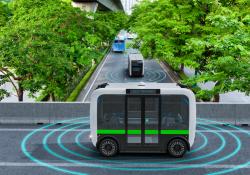A dozen years from now, will enforcement still be constrained by the legislative thinking which currently prevails? Or will the needs of the wider transport community bring about some welcome changes?
The term 'data fusion' is especially fashionable and particularly relevant when one considers cooperative road infrastructure. When it comes to enforcement and the sensor technologies used, however, it remains more of a novelty.This is driven in no small part by the inherent conservatism of the enforcement sector. Something of a necessity given the need to preserve the integrity of the evidence chain, it is nonetheless a well-documented source of frustration to systems developers and suppliers and was discussed in the article on the greater utility of digital enforcement systems.
For reasons both altruistic and commercial, systems suppliers argue that the current Type Approval process, at least in many places in Europe, stands in the way of progress when it comes to operating regimes, efficiency and, ultimately, safety. In this issue, Paolo Sodi of
Divergent opinions
But if Sodi's view highlights a common concern, the detection technologies themselves, and the relative merits of each, provoke as many responses as there are those to whom questions are posed.To many, the inductive loop is old news. And yet Bob Lees of
John Harris, European Business Development Director at
"Radar, laser and video suffer from obstruction and occlusion, whereas loop or lane detection offers precise vehicle capture and identification. But loops aren't mobile. Radar remains the best above-ground non-intrusive technology but application is always going to be a consideration when it comes to technology choice.
Loops are likely to continue as a staple detection technology on a diminishing scale fulfilling specific tasks." Daniel Tijl, Product Manager at
"For spot enforcement, I consider multiple algorithm measurement by a single detector to be the state of the art. That might be as a result of matching flank signals across a pair of loops or of Doppler calculations from radar technologies. Data fusion is more common for section control, and in-image triggering by OCR cameras is an improving technology in this respect.
"There is a lot of work going on when it comes to radar and video but loop detection still has a lot of unrealised potential. We're currently experimenting with new types of loop configurations and radar. It's important for any manufacturer to maintain flexibility in its portfolio."
Schneider even dismisses the need for data fusion: "3D radar has to be considered the state of the art for speed and red light enforcement," he says. "I just don't see loops having any significant advantage over radar any more. Fused technologies could be an efficient way of offering an independent, secondary speed check, as required in some countries, but in general I don't see a trend emerging." Geoff Collins of average speed (section control) specialist
"Loops offer a reliable trigger mechanism that won't be fooled by bad weather, vibrations or missing plates. But ANPR still has a lot to offer and I don't see one single technology which can offer a comprehensive solution," he continues.
Future drivers
Digitisation has already given greater impetus to technological development work in the detection area. Another market factor is that rising traffic densities are currently pushing greater numbers of users to specify non-intrusive solutions. John Harris notes that an associated development is the demand for increased functionality: "Different requirements are constantly being evolved by customers but enforcement is a demanding market, requiring precision and reliability. The value of the offering needs to be clearly communicated." That perhaps reflects, finally, a emerging realisation among the wider end-user community of the capabilities of digital systems and the operating paradigms they allow. It all rests on whether the legislatures can be convinced, however. Enforcement and privacy have always been uneasy bedfellows and there are knock-on effects on what is necessary in terms of data acquisition, encryption and storage. This is where the specifics of the detection technology used and the wider capabilities of digital systems start to merge."There are certain areas where the fusion of evidential integrity and the additional functionality or information which results is simple to achieve," says Nicki Bradley. "A red light camera could be used for traffic monitoring; a network of speed cameras could be used for intelligence gathering; suppliers would be easily able to provide such hybrid systems were they not hampered by legislation.
"Government agencies need to examine current policies and decide whether these still apply given the encryption and watermarking techniques available to developers. There is already a great deal of traffic enforcement equipment available for adaptation; rather than continuing to bring in new equipment for each application would it not be more advantageous to divert funds to other areas such as educating road users?" Geoff Collins concurs. He feels strongly that the use of enforcement systems for wider traffic management might lead to data fusion becoming more commonplace: "I do think there's a way forward. As long as it is designed and operated appropriately, the evidence chain will be secure."











